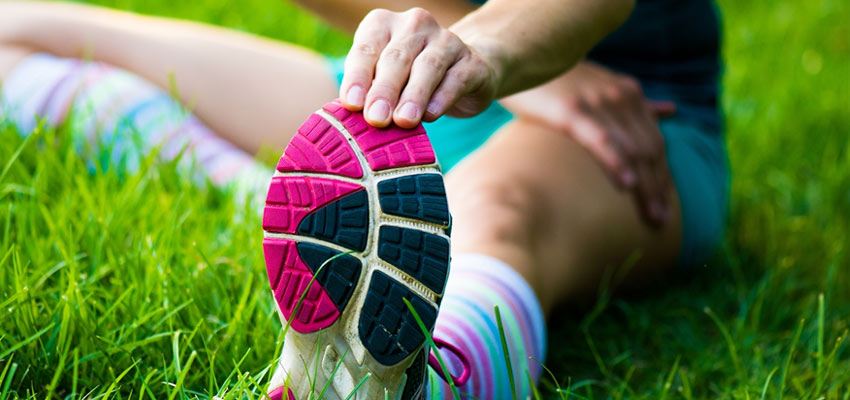7 Ways To Minimise The Chances & Effects Of An Injury
When you’re striving to improve, there’s always the chance that you could push yourself a little too much. Fortunately, there are ways to keep the odds of you sustaining an injury low. Here are seven ways to minimise the chances and effects of an injury...
Rest.
Often the main cause of injuries are errors that are performed during training. Many of these include people trying to do too much, maybe too soon or too often. Our bodies need time to recover after each and every session, no matter what that session involves. We’re often told that the path to success, to improve, is to run faster, run further, lift more weight – but this only works to a certain extent. This should be balanced with distances or weights that are manageable to ensure that you don’t do more than your body can handle.
Warm-up.
Beginning a workout without warming up increases the chances of an injury being sustained during the start of a session. If you’re going running, for example, it’s beneficial to begin with a walk which progresses into a slow jog. This can help to loosen your muscles without the risk of over-stretching. To stretch all of your leg muscles at once, lunging both forwards, backwards and sideways will certainly do that.

Keep a diary.
Continuing to make a note of the contents of every workout session will help you keep track of what you have done and when, as well as the progress that you’ve made. As well as allowing you to note what you have done previously, you can also plan ahead, where you can make sure that you give yourself a good amount of rest time. To make sure that you do keep a note, leave a diary or calendar next to something that you use every day, such as the kettle. If you’d prefer to update it straight after a workout, use an app such as Google Docs on your phone.
Self-assess.
After you have completed your warm-up, you need to ask yourself whether or not you’re ready to begin the session. If there’s any pain after you’ve completed your warm-up, whether it was sustained during or before, it might be best to stop. It may not be anything major but it could be muscle soreness which might mean that you haven’t recovered fully from your last session. If you continue with your usual workout it could make the problem worse, so a much lighter session should be the maximum that you do.
Wear comfy shoes.
When you’re running, it’s important that you are wearing suitable footwear. You may be influenced by family, friends, companies or experts but it’s difficult to tell which shoes are best for you until you try them for yourself. A study was run in Canada where soldiers were asked to test out various inserts and wear the ones that they felt were the most comfortable. It was then found that fifty-three percent of them had a lower injury rate, perhaps adding more reliability to the idea that your body knows best when it comes to footwear.
Be active.
Staying active when injured is a great way for our bodies to remain fit. Of course, these should be light sessions which do not put too much strain onto any existing injuries. Our bodies are adapted to be able to heal on the move, so any additional exercise that gets us moving and increasing our heart rates for an extended period of time will be beneficial.

Don’t rush your injury.
Injuries are often made worse, as they are not treated straight away. Something as simple as ice can be very beneficial in helping to aid it during the early stages. As tempting as it can be, try to avoid testing the injury, as you will only delay the healing process. When you’re coming back from an injury, come back slowly and don’t try to instantly make up for the lost time. If you do too much, or you start too early, your chances of suffering a setback increase meaning you’ll be out of action for longer.
Our full range of products are available on our website now at discounted prices. Orders over the cost of £50 receive free shipping. If you have any questions, please do leave a comment below or message us on Facebook or Twitter!
Categories
- Sport (28)
- Product Reviews (3)
- Team Outdoor Look (7)
- Mike Wild (2)
- Mike Payton (2)
- Suse Hammond-Pears (3)
- Snowboarding (12)
- Latest Offers (105)
- Shop Talk (1)
- Competitions (7)
- Walking (413)
- Lifestyle Fashion (8)
- Travel (86)
- Kit Guides (176)
- Workwear Clothing (6)
- Safety Workwear (4)
- Health/Fitness (289)
- Skiing (91)
- Great Outdoors (1316)
- Cycling (92)
- January 2025
- December 2024
- November 2024
- October 2024
- September 2024
- August 2024
- July 2024
- June 2024
- May 2024
- April 2024
- March 2024
- February 2024
- January 2024
- December 2023
- November 2023
- October 2023
- September 2023
- August 2023
- July 2023
- June 2023
- May 2023
- April 2023
- March 2023
- February 2023
- January 2023
- December 2022
- November 2022
- October 2022
- September 2022
- August 2022
- July 2022
- June 2022
- May 2022
- April 2022
- March 2022
- February 2022
- January 2022
- December 2021
- November 2021
- October 2021
- September 2021
- August 2021
- July 2021
- June 2021
- May 2021
- April 2021
- March 2021
- February 2021
- January 2021
- December 2020
- November 2020
- October 2020
- September 2020
- August 2020
- July 2020
- June 2020
- May 2020
- April 2020
- March 2020
- February 2020
- January 2020
- December 2019
- November 2019
- October 2019
- September 2019
- August 2019
- July 2019
- June 2019
- May 2019
- April 2019
- March 2019
- February 2019
- January 2019
- December 2018
- November 2018
- October 2018
- September 2018
- August 2018
- July 2018
- June 2018
- May 2018
- April 2018
- March 2018
- February 2018
- January 2018
- December 2017
- November 2017
- October 2017
- September 2017
- August 2017
- July 2017
- June 2017
- May 2017
- April 2017
- March 2017
- February 2017
- January 2017
- December 2016
- November 2016
- October 2016
- September 2016
- August 2016
- July 2016
- June 2016
- May 2016
- April 2016
- March 2016
- February 2016
- January 2016
- December 2015
- November 2015
- October 2015
- September 2015
- August 2015
- July 2015
- June 2015
- May 2015
- April 2015
- March 2015
- February 2015
- January 2015
- December 2014
- November 2014
- October 2014
- September 2014
- August 2014
- July 2014
- June 2014
- May 2014
- April 2014
- March 2014
- February 2014
- January 2014
- December 2013
- November 2013
- October 2013
- September 2013
- August 2013
- July 2013
- June 2013
- May 2013
- April 2013
- March 2013
- February 2013
- January 2013
- December 2012
- November 2012
- October 2012
- September 2012
- August 2012
- July 2012
- June 2012
- May 2012
- April 2012
- March 2012
- February 2012
- January 2012
- December 2011
- November 2011
- October 2011
- September 2011
- August 2011
- May 2010
- April 2010
- March 2010
- February 2010
- January 2010
- November 2009
- October 2009
- September 2009
Submit a Comment